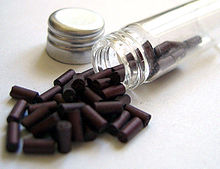Auermetall
Auermetall , sometimes mischmetal called, is the name for various pyrophoric cerium - iron - alloys . They were first manufactured by Carl Auer von Welsbach and applied for a patent in 1903 under the number DE 154807. The patent specifies 70% cerium to 30% iron as the optimal ratio.
Auermetall I is an alloy of (purified) cerium and iron , from which one can easily scrape sparks.
Auermetall II is a cerium-iron alloy enriched with the element lanthanum , which forms a particularly bright spark.
Auermetall III is created by alloying iron with unpurified cerium, which, according to its natural occurrence, is accompanied (mixed) by other rare earth metals. It was therefore also called Erdmetall and later renamed Auermetall III.
Carl Auer von Welsbach wanted to achieve economic profit with all three variants. However, the first two could not establish themselves on the market, only the cheaper Auermetall III, which is easier to manufacture, found worldwide distribution as a flint in the lighter industry .
In the past, fire was generated by hitting sparks from suitable metals (iron alloys, marcasite ) using brittle flint . In relation to this - only with the purpose in mind - the term flint was introduced for the ductile metal alloy Cereisen. The resulting sparks are generated by machining (the planing off of thin metal chips), which become so hot due to the frictional heat generated during machining that they ignite in the air and burn incandescent. The ignition wheel of lighters - in gas lighters it can also be a stick - has fine teeth made of hardened steel, like a file , which remove the characteristic immediately glowing chips from the metallic flint.
See also Mischmetall and Treibacher Industrie AG
Individual evidence
- ↑ Inventions related to gas lighting
- ↑ Carl Auer von Welsbach biography ( memento from April 12, 2016 in the Internet Archive ) on althofen.at
